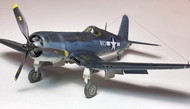Magic Factory F4U-1A/-2 Corsair, 1/48th Scale, Kit No. 5001 Part 3
By Phillip Friddell on 5th Apr 2024

When last we convened we had taken a hard look at the minor corrections necessary to put the Magic Factory Hog into the realm of models we need to build. In this final thrilling installment we’ll take a moment to wrap things up and offer a parting comment or two regarding the kit and how it builds up, but first a spoiler alert: We like this kit, and we like it a lot. In fact, we like it so much that we intend on building other variants as they become available, and we’re building the other half of this kit, the F4U-2, as this is being written. Magic Factory have done a fine job with this kit and we’re very much excited to see what the follow-on F4Us from them look like.

SO… When we first began this missive we were convinced that these newest F4U kits were nice to have but highly unlikely to replace the now-aging 1/48th scale Tamiya offerings we’ve all known and loved for the past twenty-something years. In that regard we were wrong, sort of, because the Magic Factory Corsairs raise the bar in almost every respect—that’s primarily attributable to the incredible advances made in tooling technology, of course, but the exact reason doesn’t really matter. The Tamiya Hogs were great for their time, but that time is now past and some of the things that made the kit great have been superseded by this upstart. The Magic Factory kits offer significantly finer detail, particularly in the areas of the cockpit and landing gear and are the only models of the type to date that supply a separate (and mostly proper) instrument panel for the F4U-2, and that’s regardless of scale or manufacturer. Everything offered by these new kits just presents better, and the completed model has The Look. Boy oh boy does it have The Look!

The kit suffers from a couple of warts, of course; there always are warts to be suffered when dealing with scale models, but they’re minor for the most part and easy to cope with. The big ones, the overstated fabric detail and partially inaccurate rivet detail, are largely non-starters once the model is viewed in its finished state, under a coat of paint and decaled. Yes; the -1A offered is an earlier one with the early landing light configuration (probably to allow the same wing tooling to be used for both the -1A and -2), but the only thing that actually bothers us regarding the kit out of the box is the clunky rudder trim tab linkage, which honestly could and should have been dealt with using a separate component. We’re also a bit annoyed that the manufacturer saw the need for dropped flaps when that condition was a rarity on the real airplane when parked on the ground, but that’s something that’s easily corrected should you choose to do it.
In summary, we think this Corsair kit is presently THE Corsair kit in 1/48th scale. We’re not throwing out our unbuilt Tamiya kits, mind you, but it’s become highly doubtful that we’ll actually build them. In fact, we enjoyed working with our review subject so much that we’re now hip-deep in the construction of the kit’s companion F4U-2 offering. This model is addictive!
One final thing before we go: You’ve probably noticed by now that there’s something wonky about the national insignia on our review model. That’s because we chose to ignore the kit's superb decals, printed by Cartograf and excellent in every way (we tried a couple of the kit decals on a test mule and they’re great, so that isn’t just hyperbole on our part), and instead used a set of USMC Corsair markings provided by Fundekals. Our decision to do that was based both upon their selection of markings (883 was flown in combat by Greg Boyington, an airplane we wanted to replicate) and by their scholarship. Recent research has unearthed a document requiring blue overpainting of national insignia outlines during the time period in which 883 was operational and existing photography, both in black and white and in color, confirms that it was a fairly common practice among Marine Corsair units in the Southwest Pacific. The resulting model provides a substantially different approach to F4U markings and we like it.
It’s been a while since we’ve enjoyed building anything as much as we have while working with this kit, and it definitely captures the lines and “feel” of the Corsair. Our own personal list of recommended kits is somewhat limited but this one is most assuredly in that category. If you like the Corsair you could do a whole lot worse than building a Magic Factory Hog. Or two, or several…
That’s our story and we’re sticking with it!

